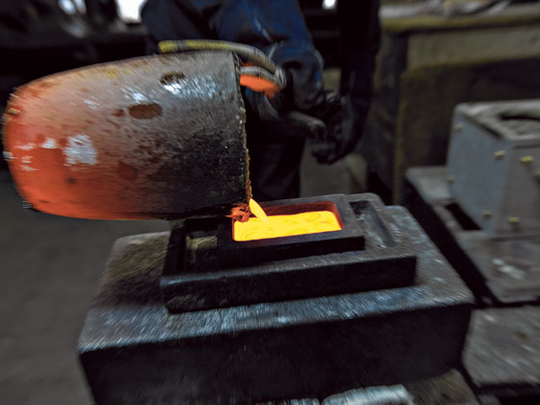
London: James Burton did not have a penny invested in gold of the $142.8 billion (Dh525.12 billion) he managed as chief executive officer of the California Public Employees' Retirement System in 2002. Why would he?
The metal had been in a bear market for two decades. Yet shortly after announcing his retirement from the largest public pension fund in the United States, Burton agreed to fly to London to entertain a job offer from a mining companies trade group.
Squishing across a rain-soaked British golf course in rented shoes in June 2002, he listened to what sounded like a far-fetched idea: Selling gold as an investment to the masses. It was time to get investors to buy a precious metal they had shunned for a generation, Christopher Thompson, the World Gold Council's new chairman, told him that day.
The key was dividing bars of gold into securities tradable on the New York Stock Exchange. He wanted Burton to lead the effort. Gold was then trading at about $328 an ounce in London. "I was convinced that there was a market for the man on the street," says Thompson, 62, who at the time was also chairman of Johannesburg-based Gold Fields.
Thompson bested Burton in match play on the 17th hole, convincing him to take the job as the World Gold Council's CEO. What the two did next shows the role mining companies played in gold's longest bull run in at least 90 years, reaching a record $1,431.25 an ounce on December 7.
Under the men's leadership, a trust set up by the World Gold Council, which includes producers such as Barrick Gold Corp and Newmont Mining Corp, won approval from the Securities and Exchange Commission for an exchange-traded product backed by bullion.
Hedge fund titans
It gave investors access to gold without the cost and hassle of taking physical delivery. The fund, SPDR Gold Trust (pronounced Spider), now holds 1,299 metric tonnes of gold valued at about $57 billion, more than the Swiss central bank.
Investors include the University of Notre Dame, the Texas teachers' pension fund and a who's who of hedge fund titans and money managers such as John Paulson's Paulson & Co, Laurence Fink's BlackRock Inc and George Soros' Soros Fund Management.
Globally, the 10 biggest such funds hold a combined 2,113 metric tonnes of gold, more than the official reserves accumulated by every country except for the United States, Germany, Italy and France.
Their popularity has helped drive unprecedented gains for the precious metal. Some people, including analysts at Goldman Sachs, say gold can go higher. Soros, who made $1 billion betting against the British pound in 1992, called gold the "ultimate asset bubble" at the World Economic Forum's January meeting in Davos, Switzerland, when the price was $1,087.10 an ounce.
His fund held $664.8 million in gold-backed exchange-traded funds as of September 30. Gold's rise resembles moves reached before the three big crashes of the last decade: the Nasdaq tech-stock bubble of 2000; the US housing market bubble of 2005-2006; and the oil-price spike of 2008, according to data compiled by Bloomberg.












